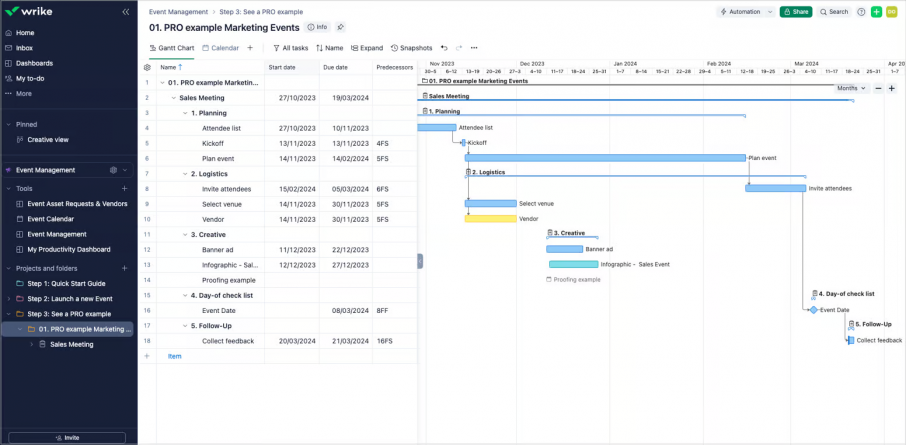Key takeaways:
- Why should anybody use an event planning template? It helps avoid disorganization, outlines tasks, and keeps the planning process on track.
- What are the key components? Essential parts include event objectives, budget planning, venue selection, marketing, guest registration, entertainment, and a timeline.
- How does it streamline planning? Breaking tasks into manageable chunks improves delegation and reduces misunderstandings, ensuring timely completion.
- Which formats are available? Templates can be created using spreadsheets, project management software like Wrike, or custom design tools for visual appeal.
- How does it save time and reduce stress? A reusable template simplifies planning, allowing focus on creative aspects while managing logistics efficiently.
Event planning can be a daunting task. Without a proper plan in place, it can quickly become disorganized and overwhelming. An event planning template is a useful tool that can make your planning easier, keep things organized, and save time.
This article will talk about the significance of an event planning template. It will explain the important parts of the template and the different formats you can use for your organization.
To manage your event planning process more effectively, a comprehensive platform like Wrike can be a great help. Experience firsthand how it seamlessly enhances your event planning by taking advantage of a 14-day free trial of Wrike.
Understanding the importance of an event planning template
You can avoid getting lost in the small details by using an event planning template. The template should outline the various components and tasks involved in planning an event. This will make it easier to anticipate problems, plan contingencies, and stay within budget. You can use the template when planning for various events, such as a small gathering or a large conference.
Streamline the planning process
One of the biggest advantages of using an event planning template is the ability to streamline the planning process. Break plans into smaller tasks to track progress and ensure everything is on schedule. This makes it easier to delegate tasks more efficiently and avoid misunderstandings and communication breakdowns.
If you’re planning a conference, an event planning template can help you identify all the tasks involved. This should include booking a venue, hiring speakers, arranging travel and accommodation, and managing registrations. By dividing tasks into smaller parts, you can be confident that everything will be done on time and within budget.
Ensure consistency and organization
Consistency and organization are key to a successful event. An event planning template ensures that all aspects of the event follow a structured process. From handling registration to catering to speaker management, each item follows a predefined guideline that can be replicated for future events. This consistency helps ensure a smooth experience for attendees and minimizes disruption.
Save time and reduce stress
Organizing an event from scratch can be intimidating and time-consuming. An event planning template saves time by breaking down all the planning into manageable chunks.
Once the template is created, you can reuse it multiple times and make minor adjustments that are tailored to the specifics of each event. This reduces the workload, as well as stress levels in the long run.
Because you don’t need to start over every time you plan an event, you can focus on other important things, such as marketing and promotion.
Identifying the key components of an event planning template
An event planning template should cover all aspects of event planning and include the following essential components:
Event objectives and goals
What are you trying to achieve with this event? Identifying the main objectives and goals will help shape the direction of the event and prioritize tasks. Ensure this section is specific, measurable, achievable, relevant, and time-bound (SMART)!
If you are planning a charity event, your objective might be to raise a specific amount of money for a particular cause. You can break down the goal into smaller, more achievable targets to track progress. Alternatively, if it is a corporate event, your goal might be to increase brand awareness and generate leads. You can measure the success of the event by tracking the number of attendees who become leads or the number of social media mentions.
Event budget template and financial planning
Creating a budget template is vital to prevent overspending as well as underspending. It will assist you in identifying the necessary funds and ways of sourcing them. It can also indicate areas where you might need to cut costs and create savings.
When creating a budget, consider all the expenses you might incur, such as venue rental, catering, entertainment, and marketing. Allocate funds to each aspect of the event and leave some room for contingencies.
Venue selection and logistics
Selecting the ideal venue is crucial. When choosing a venue, consider the location and accessibility for attendees, since it should be easy to find and have ample parking space. Ensure the venue can accommodate the number of attendees you expect and has the necessary amenities, such as restrooms, parking, and catering facilities.
Marketing and promotion
You must promote the event effectively to attract and retain attendees. This section should outline the marketing channels to use, such as social media, print media, email, and the corresponding marketing materials.
Remember to consider the target audience and the most effective channels to reach them. If the event is targeting young professionals, social media platforms such as LinkedIn and Twitter might be more effective than print media. Additionally, creating engaging marketing material such as videos and graphics is an effective strategy to attract attention.
Guest list and registration
You need to keep track of who is attending the event, who has registered, and who has canceled. A smooth registration process helps track attendee details and gather their information and feedback.
Make the registration process as easy to use as possible and provide all the necessary information, such as the event date, time, and location. You could even collect feedback from attendees to improve future events.
Entertainment and activities
Attendees expect to be entertained and participate in engaging activities. This section should outline the entertainment and activities that have been planned and how they will be coordinated.
Consider planning activities that are engaging and relevant to the event’s theme. They should be well coordinated and have enough staff to manage them.
Timeline and schedule
A clear timeline will hold everybody involved accountable when it comes to meeting deadlines. Your schedule should be as detailed as possible, with an outline of each task and an estimated completion time.
Try to make the timeline as realistic as possible and provide enough time for each task. Also, don’t forget to communicate the timeline and schedule to all involved parties to avoid confusion and ensure everyone is on the same page.
Choosing the right format for your event planning template
There are different formats you can use to create an event planning template, each with its own benefits and drawbacks.
Spreadsheet templates
A spreadsheet template can be a useful tool for event planning because it allows you to capture all the information in one place. You can create columns for different categories, such as the event date, location, budget, vendors, and attendees. By using formulas, you can easily calculate costs and create a budget tailored to your needs. You can also track RSVPs and create a guest list.
However, spreadsheets can be overwhelming if you’re not familiar with them, and they may not be visually appealing.
Project management software
Project management software like Wrike can help manage tasks and deadlines and track progress. It’s easy to collaborate in real time using software like this, making it ideal if you’re working with a dispersed team. You can create boards for different categories and even assign tasks to team members and set deadlines.
To give you a quick peek into Wrike’s capabilities, here’s a screenshot demonstrating its ability to manage tasks and track progress.

Customized event planners
You can also create your own customized event planning tools using platforms like Canva or Adobe — perfect for creating a visually appealing template that you can customize to match your event’s theme. Create an attractive template with pictures, colors, and graphics, then customize it to include all the important details.
However, creating a customized event planning tool can be time-consuming, and it may require design skills that you may not have.
No matter which format you choose, the most important thing is to have a plan in place. By using an event planning template, you can stay organized, save time, and reduce stress. You’ll be able to focus on the creative aspects of planning your event, such as choosing the perfect venue, décor, and menu, knowing that all the logistical details are taken care of.
Conclusion
An event planning template is a must-have to ensure the success of your event. It helps streamline the planning process, maintains consistency and organization, saves time, and reduces stress. Identifying the key components of an event planning template and choosing the right format are also essential.
Even though creating a template may seem daunting, it is well worth the effort. You will have the confidence and ability to run a smooth, successful event and create future efficiencies. So, get to it and create a template today!
Master your event planning process with an efficient template crafted in Wrike’s customizable workspace. Begin your free trial now and ensure the smooth execution of your events from start to finish.
Note: This article was created with the assistance of an AI engine. It has been reviewed and revised by our team of experts to ensure accuracy and quality.
Power the Modern, Agile Enterprise
Crush your goals and keep moving forward with Wrike’s work management platform.







